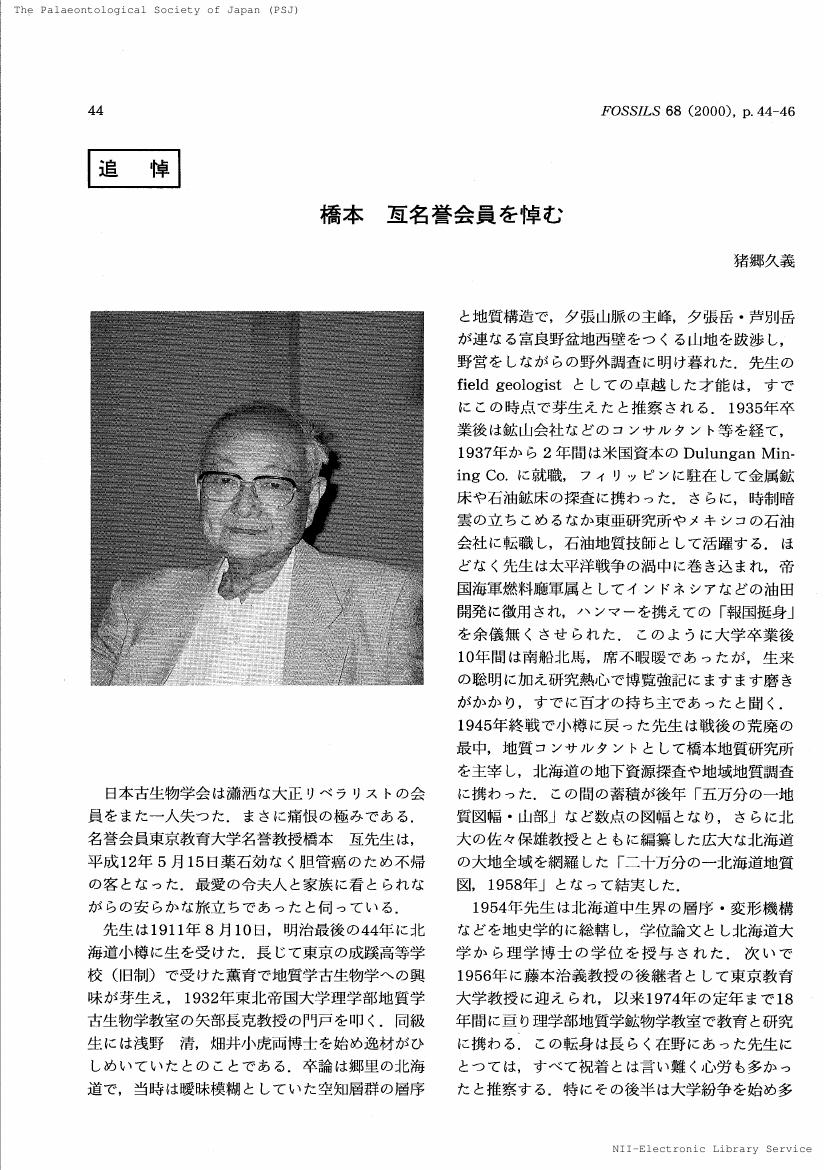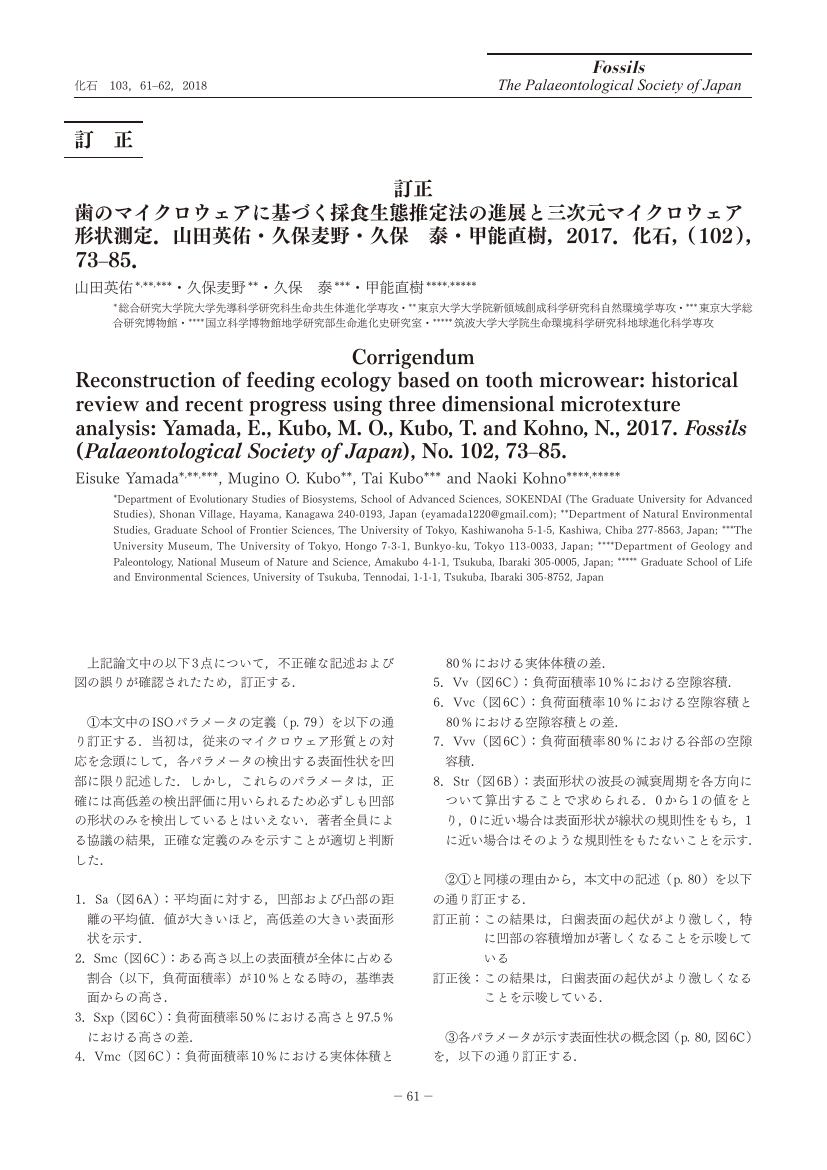1 0 0 0 OA ミランコビッチ・サイクルに伴う環境変動に対する海生貝類の応答様式
- 著者
- 北村 晃寿
- 出版者
- 日本古生物学会
- 雑誌
- 化石 (ISSN:00229202)
- 巻号頁・発行日
- vol.63, pp.40-48, 1997-12-20 (Released:2017-10-03)
- 参考文献数
- 36
The middle part of the early Pleistocene Omma Formation (1.5-1.0Ma) is composed of eleven depositional sequences caused by glacio-eustatic sea-level changes associated with Milankovitch cycles (41, 000-year orbital obliquity). Each depositional sequence contains inner shelf sediments of transgressive and high-stand systems tracts. Within each depositional sequence the molluscan fauna changes from cold-water associations to warm-water associations, followed again by cold-water associations. On the basis of detailed stratigraphic distributions of molluscs and planktonic foraminifers, the following events can be recognized during the warming interval from a glacial stage to an interglacial stage : 1. initiation of inflow of the warm Tsushima Current into the Japan Sea, 2. local extinction of cold-water molluscs, 3. absence of both cold-and warm-water molluscs, 4. successful migration of warm-water molluscs. The absence of both elements may have been caused by high seasonal fluctuations of water temperature associated with the unstable inflow of the Tsushima Current.
1 0 0 0 OA 首長竜(ふぉっしる)
- 著者
- 佐藤 たまき
- 出版者
- 日本古生物学会
- 雑誌
- 化石 (ISSN:00229202)
- 巻号頁・発行日
- vol.85, pp.69-71, 2009-03-31 (Released:2017-10-03)
- 参考文献数
- 16
1 0 0 0 OA 始新世/漸新世境界付近における南大洋の古海洋学
- 著者
- 舟川 哲
- 出版者
- 日本古生物学会
- 雑誌
- 化石 (ISSN:00229202)
- 巻号頁・発行日
- vol.73, pp.20-37, 2003-03-20 (Released:2017-10-03)
- 参考文献数
- 83
本論では, 南大洋における後期始新世から漸新世にかけてのテクトニクスイベントおよび堆積物から読みとれる気候イベントを総括し, 海洋の微化石群集の変化が, これらとどのように結びついているかを論じた(図14).(1)後期始新世では, 南タスマン海膨が沈降を開始し, インド洋-太平洋間に海路が徐々に形成され始めた.すでにこの時期に海水温の低下がみられるが, その原因はよくわからない.酸素同位体比および南極大陸縁辺の堆積物からみると, このとき南極大陸には短期間ではあるが, 小規模な氷床が形成されていた.この寒冷化によって, 海洋の石灰質微化石(浮遊性有孔虫, 石灰質ナノ化石)は, 温暖種が段階的に絶滅した.珪質微化石は, 温暖種が徐々に絶滅する一方で, 新たに出現する種がみられるようになり, 群集全体の種数も増加した.(2)E/O境界付近では, インド洋-太平洋間に表層水が通過できるような海路(タスマニア海路)が形成され, 周南極海流の原型が出現した.このため南極大陸ではさらに寒冷化が進み, 東南極大陸を中心として大規模な氷床が拡大した(Oi1イベント).この時期は, 北大西洋における深層水(NCW)の出現時期とも重なる.氷床の拡大と同時に, 現在の南極発散線に相当する湧昇域が出現し, 海洋表層の生産性が増大した.これに伴って, 珪藻の出現イベント, 放散虫群集の構成種の入れ替わり, 石灰質ナノ化石群集における寒冷種の増加などが起きた.(3)前期漸新世の前半(33.7〜30Ma)では, 海洋微化石群集はそのほとんどが寒冷種群から構成されており, 構成種の入れ替わりや新たな種の出現はほとんど認められない.その後, 前期漸新世の後期では, 南極半島の縁辺にあるパウエル海盆が開き, 太平洋と大西洋の間に表層〜中層水が通過できる海路が形成され, 現在の形に近い周南極海流が完成した.これに伴い, 南極大陸では, 前期/後期漸新世境界の付近でふたたび大規模な氷床の拡大がおこった(Oi2aイベント).
1 0 0 0 OA メタセコイアの発見と普及 ―三木 茂博士の発見から75年―
- 著者
- 塚腰 実
- 出版者
- 日本古生物学会
- 雑誌
- 化石 (ISSN:00229202)
- 巻号頁・発行日
- vol.100, pp.1-2, 2016-09-30 (Released:2019-04-03)
1 0 0 0 OA 本邦白亜系における海成・非海成層の対比
- 著者
- 松本 達郎 小畠 郁生 田代 正之 太田 喜久 田村 実 松川 正樹 田中 均
- 出版者
- 日本古生物学会
- 雑誌
- 化石 (ISSN:00229202)
- 巻号頁・発行日
- vol.31, pp.1-26, 1982-06-21 (Released:2017-10-02)
- 被引用文献数
- 1
In various areas of Japan, non-marine sediments (s.l.) of fluviatile, lacustrine, and brackish-water environments are frequently interfingered with marine ones which contain index species of ammonites and other groups. Therefore, the geological age of the former can be determined by that of the latter in terms of the international scale. The result of the correlation on available evidence is shown in three charts (Figs. 1-3), in which ammonites, other marine biota, brackish-water fauna, fresh-water fauna and land-plants are also stratigraphically allocated. Outside the scope of the three charts, the biostratigraphically well subdivided marine sequences of Hokkaido and the Campanian-Masstrichtian sequences of Southwest Japan do contain transported remains (petrified woods, seeds, leaves, pollen and spores) of land-plants in favourable preservation, whose geological ages can also be determined in terms of international scale. On the ground of these results, the evolutionary history of the non-marine faunas and floras can be studied precisely. This would in turn be a foundation for the correlation of the continental deposits in Eastern Asia. This paper is a contribution to the IGCP Project No.58 Mid-Cretaceous Events [MCE].
1 0 0 0 日本産化石カメ類研究の概要(ふぉっしる)
- 著者
- 平山 廉
- 出版者
- 日本古生物学会
- 雑誌
- 化石 (ISSN:00229202)
- 巻号頁・発行日
- vol.80, pp.47-59, 2006
- 参考文献数
- 69
- 著者
- 郡司 幸夫
- 出版者
- 日本古生物学会
- 雑誌
- 化石 (ISSN:00229202)
- 巻号頁・発行日
- vol.50, pp.26-32, 1991-07-20 (Released:2017-10-03)
1 0 0 0 OA 北海道士別市北西,湖南から産出する中期中新世植物化石群
- 著者
- 成田 敦史 植村 和彦 松本 みどり 矢部 淳
- 出版者
- 日本古生物学会
- 雑誌
- 化石 (ISSN:00229202)
- 巻号頁・発行日
- vol.92, pp.5-18, 2012-09-28 (Released:2017-10-03)
- 参考文献数
- 44
A late Middle Miocene megafossil flora (Konan Flora) is preserved in lacustrine deposits in the Konan Tuffaceous Sandstone and Mudstone Member of the Bifuka Formation in Shibetsu City, Hokkaido, the northernmost island in Japan. The Konan Flora is composed of 38 taxa in 17 families and 24 genera and includes 4 evergreen conifers, 1 monocotyledonous perennial herb, 33 deciduous dicots, and 2 seeds of unknown affinity. The most dominant species in the flora is Fagus palaeojaponica, followed by Acer subcarpinifolium, A. protojaponicum, Picea sp., Salix sp., Cercidiphyllum crenatum, Betula protoglobispica, and Cladrastis chaneyi. The vegetation inferred from the Konan Flora is broad-leaved deciduous or mixed northern hardwood forest which is typical in northern Japan at the Middle Miocene. The composition and components of the Konan flora are similar to those of the Late Miocene Mitoku-type floras in Hokkaido. The leaf physiognomy and quantitative climate analysis based on the CLAMP (Climate Leaf Analysis Multivariate Program) revealed that the prevailing climate was a wet cool temperate climate similar to modern Hokkaido or northern Honshu. Compared with Sakipenpetsu flora (early Middle Miocene), Shanabuchi flora (Late Miocene) and Rubeshibe flora (Early Pliocene), there were no great differences between the Konan flora and those three floras in terms of climatic conditions.
1 0 0 0 OA 橋本互名誉会員を悼む
- 著者
- 猪郷 久義
- 出版者
- 日本古生物学会
- 雑誌
- 化石 (ISSN:00229202)
- 巻号頁・発行日
- vol.68, pp.44-46, 2000-09-20 (Released:2017-10-03)
1 0 0 0 OA 日本産化石カメ類研究の概要(ふぉっしる)
1 0 0 0 OA 計算微古生物学:最新 3 次元イメージング技術の浮遊性有孔虫研究への応用
- 著者
- 佐々木 理 岩下 智洋 木元 克典 鹿納 晴尚 木原 辰之
- 出版者
- 日本古生物学会
- 雑誌
- 化石 (ISSN:00229202)
- 巻号頁・発行日
- vol.99, pp.63-72, 2016-03-31 (Released:2019-04-03)
The planktonic foraminifera are distributed across the world’s oceans, of which the shells are preserved in the ocean sediments, forming one of the most complete fossil records on earth. The record is used to date sedimentary rocks and study evolutionary processes, and is one of the most important archives of the past ocean condition. The appearing micron resolution X-ray CT (MXCT) can bring new information into the micropaleontology by the innovating data acquisition, visualization, measuring, morphometry, modeling and data shearing of foraminifera specimens. Anthropogenic CO2 changes the carbonate chemistry and the pH of the surface ocean. The ecological effects of the change are largely unknown and need to be quantified. The quantitative CT method with MXCT has become possible to measure the mineral density and visualize the density distribution in the micron-scale shell of foraminifera. The application to the living and fossil foraminifera might provide novel information about the ocean acidification ongoing in the modern ocean and occurred in the past one. The advent of molecular biological techniques has led to the discovery of previously unrecognized genetic diversity of the modern species recognized based upon the shell morphology. However, until recently the best information on shell shape was only obtained through SEM images, giving limited measuring accuracy of 3D shell shape. The reverse technology with MXCT has upgraded the morphometry of this group by shifting the data from SEM images to CT data. The famous models made by 19th Century paleontologist d’Orbigny shows clearly that it has been difficult to shear the morphological information of specimens because of its micron size. Instead of such handcrafted models, the Internet delivery of the virtual model generated from MXCT images has become possible to shear the high-precise morphological data of taxonomic type specimen. The applications here illustrate the possibilities of computational micropaleontology, which has established in a new interdisciplinary field between the state-of-the-art three-dimensional imaging technology and the biogeoscience.
1 0 0 0 元会長平野弘道先生の急逝を悼む
- 著者
- 安藤 寿男
- 出版者
- 日本古生物学会
- 雑誌
- 化石 (ISSN:00229202)
- 巻号頁・発行日
- vol.96, pp.41-43, 2014
1 0 0 0 本邦産白亜紀アンモナイトデータベースおよび種多様性について
1 0 0 0 白亜紀海洋無酸素事変の解明(<特集>白亜紀海洋無酸素事変の解明)
- 著者
- 平野 弘道
- 出版者
- 日本古生物学会
- 雑誌
- 化石 (ISSN:00229202)
- 巻号頁・発行日
- vol.53, pp.49-51, 1992
1 0 0 0 白亜紀中期の生物事変と古環境変動
1 0 0 0 OA 貝類が受ける捕食現象とエスカレーション
- 著者
- 佐藤 武宏
- 出版者
- 日本古生物学会
- 雑誌
- 化石 (ISSN:00229202)
- 巻号頁・発行日
- vol.57, pp.50-63, 1994-11-30 (Released:2017-10-03)
これまでの各論で述べた様々な動物群による捕食形式とその捕食器官, また捕食によって生じる捕食痕についてまとめたものが, 表2である.本論では化石に残る捕食痕を生じさせる捕食様式に焦点をあてて議論を進めてきた.破壊という捕食様式を中心として捕食被食の関係を観察する際に, 被食者である巻貝を例にとると, その対捕食者戦略としてはVermeij (1983)などがまとめた, 密な巻き方, 外部装飾, 殻口部の肥厚と歯の存在などといった物理的な戦略が第一に挙げられるだろう.このような形態的な対捕食者戦略は化石サンプルからもその発達を考察することができるため, 極めて重要である.しかし, 現実には形態的な対捕食者戦略以外の戦略を採用しているものも少なくない.例えば毒を持つ, 捕食者にとってまずさを感じさせるような防御機構を持つといった化学的戦略も有効であろう.また, 生態的な戦略としては二枚貝の持つ固着の戦略(Harper, 1991)やイタヤガイ科貝類の遊泳(Hayami, 1991), 堆積物の中に深く潜るといった戦略, あるいは捕食に対しては直接的には何の防御手段を持たないがr戦略的な繁殖様式を持つといった戦略も考えられるだろう.進化の過程において海底洞窟などのような捕食圧の低い, 隠生的な環境に生息することによって原始的な形態を保持しつづけているグループも報告されている(Hayami and Kase, 1992).破壊という捕食様式に注目すると, 各論で詳しく述べたようにタマガイ科, アクキガイ科の巻貝, タコの仲間, カニの仲間, およびシャコの仲間による捕食は極めて特徴的な捕食痕を示すものであり, 捕食されて破壊された貝の貝殻や再生痕の認められる貝殻から捕食者をある程度特定することが可能であろう.このような捕食者と被食者の種間関係を硬組織上に記録された情報から推定することが可能であるということは化石サンプルへの応用を考える際には非常に重要な意味を持つであろう.なぜならば種間関係の時間的な推移を知ることで初めて具体的なエスカレーションの検証が可能になるからである.しかし, それにはまだいくつかの問題点も残されている.その一例として非生物学的な破壊, すなわち運搬や堆積に伴う物理化学的な殻の破壊や欠損と捕食による破壊を分離する必要がある.ということが挙げられよう.Kidwell and Baumiller (1990)は堆積物と水を満たした回転ドラム内にウニの標本を入れて様々な条件下での破壊や磨滅の様子を詳しくしらべているが, 同様に堆積物を加えた回転ドラムや流水水槽などを用いて貝殻の物理的な破壊実験を行ってその特徴を分析する, あるいは様々な条件下での貝殻の溶触実験を行って比較を行うなどの実験的なアプローチが必要であろう.また, この生物による破壊と非生物起源の破損を分離することはこれまでの古環境解析の手法にも大きな問題を提起するだろう.これまでは産出化石が自生的なものか他生的なものかということは, 捕食の影響を考えずに, 古環境の復元に際して重要な鍵であるとされてきた.しかし, 実験等によって得られた知見などによって堆積過程における破壊を単離することが可能になるならば, より一層精度の高い古環境復元が可能になると予測される.破壊された化石サンプルを加えて化石を評価することができるということはある意味では非常に無駄の少ない研究であると言えよう.これまでの古生物学の研究の主題には分類学や機能形態学といった完全な標本が必要とされるものが多く選ばれており, 不完全な, 破壊の見られる標本はしばしばなおざりにされてきた.しかし, 破壊された個体も含めて群集内のすべての個体を評価することを主眼とした研究においては.「不完全な」個体は非常に重要な意味を持つ.また, このような個体群動態を通じて進化プロセスを考察する研究ではいわば(伝統的地質学にありがちな)山師的な研究方法が通用しないということがいえよう.分子古生物学の分野でもどれだけ古い化石サンプルからDNAやタンパク質を抽出することができたか, という方針に対して分子のデータを用いて系統関係を再構築したり, 種分化を伴う生物地理学に応用したりといった方針の重要性が説かれている.それと全く同様に捕食被食の関係を研究する場合でも, 捕食痕を持つ最古の化石を追い求めることももちろん重要ではあるが, 多くのサンプルを用いた群集の時間的推移やその進化プロセスを検討する研究も重要であることはいうまでもないだろう.これまで多くの種間で捕食被食の関係は確認されているが, その共進化システムやエスカレーションのプロセスにまで考察を加えたものは多くはない.各論で述べたように被食者を中心としたその対捕食戦略の発達について水槽実験や化石標本の形態計測などから検討したものはいくつか見られるが捕食者の捕食戦略に対して考察を加えたものはほとんど見られない.佐藤(1994)は浅海域における巻貝の重要な捕食者であるガザミPortunus (P.) trituberculatusの捕食器官であるハサミの同種内での地理的変異とその被食者の分布パターンとの関係がエスカレーションによって導かれる結論に調和的であることを指摘しているが, 今後このような, 捕食者と被食者のそれぞれの戦略を比較した研究が多く行われることが必要であろう.理論的な捕食被食関係のシミュレーションや実験を中心とした考察は一般に一対一の種間関係のみで行われてきた.しかし, 現実にはある被食者に対して複数の捕食者が影響を与えていたり, ある捕食者が複数の種を捕食したりすることは一般的に見られることである.のみならず, ある種が捕食者であると同時に被食者であるような中間捕食者の立場や共食いを行う種である場合もあり得る.さらにある種が捕食被食の種間関係によってのみ制約を与えられている場合は極めて稀であり, その他にも競争関係や共生関係, 資源利用の制約といった複雑な種間関係から同時に制約を与えられていることが多い.複数の系に対するシミュレーションや実験等のアプローチはまだその手法も十分に確立されているとは言い難いが, 複雑な系における進化プロセスを考察することによってこそいわば拡散共進化的な群集全体の進化過程がより明確に理解されるのではないだろうか.また, 現生生物の観察においてもどの種間関係がその種にどれだけの影響を与えているのかを単離することや, その種間関係によってもたらされる同種内異変をどう解析するかが今後の課題として重要性を持つであろう.
1 0 0 0 IR アルビアン上部〜セノマニアン下部の生層序 : 北海道シューパロ地域の場合
In connection with the global standard of the Albian-Cenomanian boundary which was proposed at Brussels in 1995 and has been under discussion, we are working on the biostratigraphy of the late Albianearly Cenomanian succession in selected areas of Hokkaido. In this paper a result of our study in the Shuparo Valley of central Hokkaido is presented. Although the clastic sedimentaries in the area are not necessarily prolific, some worldwide ammonoid species have been obtained at several horizons (see Figure 1), which are tentatively correlated with the subzones in West Europe (Table 1). The stage boundary can, thus, be placed approximately between the Members IIb 2 and IIc in this area. There is, however, a considerable difference in the faunules of successive subzones between Japan and West Europe. In comparison with the ammonite biostratigraphy, some comments are given on the previous results of the foraminiferal biostratigraphy in this area. There are layers of tuff at several levels in the succession of Hokkaido, which would be useful to supplement the biostratigraphic correlation.
1 0 0 0 OA アルビアン上部〜セノマニアン下部の生層序 : 北海道シューパロ地域の場合
- 著者
- 松本 達郎 西田 民雄
- 出版者
- 日本古生物学会
- 雑誌
- 化石 (ISSN:00229202)
- 巻号頁・発行日
- vol.68, pp.1-12, 2000-09-20 (Released:2017-10-03)
- 参考文献数
- 35
- 被引用文献数
- 1
In connection with the global standard of the Albian-Cenomanian boundary which was proposed at Brussels in 1995 and has been under discussion, we are working on the biostratigraphy of the late Albianearly Cenomanian succession in selected areas of Hokkaido. In this paper a result of our study in the Shuparo Valley of central Hokkaido is presented. Although the clastic sedimentaries in the area are not necessarily prolific, some worldwide ammonoid species have been obtained at several horizons (see Figure 1), which are tentatively correlated with the subzones in West Europe (Table 1). The stage boundary can, thus, be placed approximately between the Members IIb 2 and IIc in this area. There is, however, a considerable difference in the faunules of successive subzones between Japan and West Europe. In comparison with the ammonite biostratigraphy, some comments are given on the previous results of the foraminiferal biostratigraphy in this area. There are layers of tuff at several levels in the succession of Hokkaido, which would be useful to supplement the biostratigraphic correlation.





